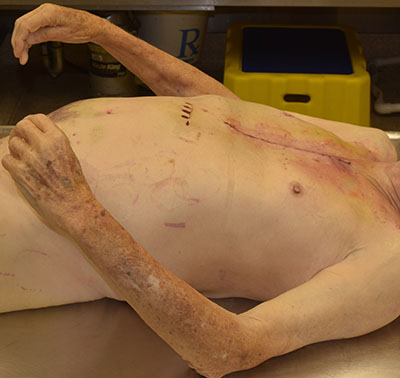
Rigor mortis is a recognizable sign of death characterized by stiffening of the muscles of the corpse. It is the fourth stage of death. It is caused by chemical changes in the muscles postmortem (after death).
In humans, it can occur in the muscles of the face as soon as two hours after death, and progresses to the limbs over the next few hours. It is a temporary condition, lasting for about 24 hours.
The muscles of the face and neck are often the first to be affected, and the rigidity spreads backwards over the trunk and limbs.
The main cause of rigor mortis is depletion of the cell's energy molecule, ATP. Without ATP, cross-bridging locks muscles in place.
The temperature around the body can affect the rate of rigor mortis. Hot temperatures increase the rate of rigor, while cold temperatures slow it down.
In some cases, rigor mortis doesn't occur. This phenomenon is most common in frail or weak people, specifically children, who do not have the necessary muscle mass to experience complete stiffening of the muscles.
The term comes from the Latin word rigor, which means "stiffness", and mortis, which means "death".
Stages of Rigor mortis
0–8 hours: The body begins to harden but is still movable
8–12 hours: Muscles become fully stiff
12–24 hours: Muscles stay solid and stiff
24–36 hours: Stiffness disperses, and muscles become flexible
Physiology
After death, aerobic respiration stops, leading to the depletion of oxygen used in producing adenosine triphosphate (ATP). ATP is crucial for separating actin-myosin cross-bridges during muscle relaxation. In the absence of oxygen, the body may resort to anaerobic glycolysis to continue producing ATP. However, once glycogen stores are depleted, ATP levels decrease, and the body enters rigor mortis because it is no longer able to break the cross-bridges.
Calcium enters the cytosol postmortem. The sarcoplasmic reticulum's deterioration releases calcium into the cytosol, and breakdown of the sarcolemma allows more calcium to enter. This calcium activates actin-myosin cross-bridging by binding to troponin on thin filaments. This binding changes the troponin-tropomyosin complex's shape, enabling myosin heads to bind to actin proteins' active sites. In rigor mortis, myosin heads continue binding to actin via adenosine diphosphate (ADP), preventing muscle relaxation until further enzyme activity degrades the complex. Normal relaxation requires replacing ADP with ATP, which destabilizes the myosin-actin bond and breaks the cross-bridge. In the absence of ATP, muscle tissue breakdown by endogenous or bacterial enzymes during decomposition is necessary. This process degrades the myosin heads, allowing muscle contraction to cease and the body to relax.
Myofilament decomposition typically occurs 48 to 60 hours after the peak of rigor mortis, which usually happens around 13 hours after death.